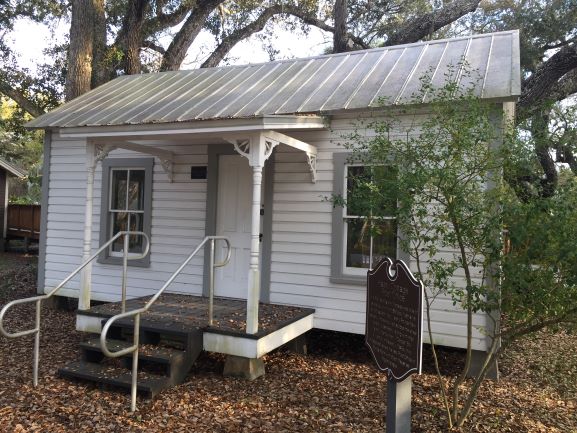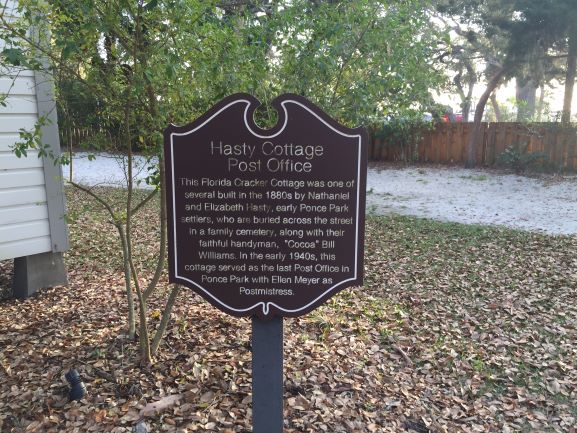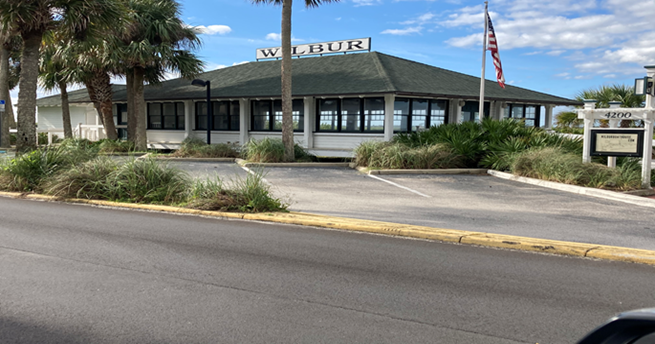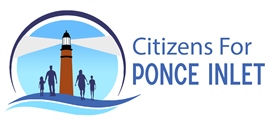DAVIES LIGHTHOUSE PARK & PLAYGROUND
March 21, 2021
by Lauren Albinson, Video Contributor
The following includes information taken from the Ponce Inlet Lighthouse & Museum’s website and from the Town of Ponce Inlet’s website:
The Kay & Ayres Lighthouse Park is a beautiful and unique park located in the shadow of the historic Ponce Inlet lighthouse just a stone’s throw from the Atlantic Ocean, the Halifax River and the inlet that connects the two. The park is named in honor of Ponce Inlet’s first mayor, Ayres Davis, the first mayor of Ponce Inlet, and his wife, Kay. The Davies were long-time residents of the area who advocated for the incorporation of the Town of Ponce Inlet in 1963. Mr. Davies was also a founding member of the Ponce de Leon Lighthouse Preservation Association that literally saved the adjacent historic lighthouse, the tallest in the State of Florida, from years of decay and eventual destruction after its abandonment by the U.S. Coast Guard until its acquisition by the Town of Ponce Inlet from the Federal Government in 1972. The association, after completely restoring and preserving the lighthouse, its adjacent buildings and grounds, currently continues to manage it, and was responsible for the restoration of its light as a functioning beacon for seafarers.
The park occupies three acres of land that was originally part of the lighthouse reservation from the time of the tower’s construction in 1887 where sections of the park had served as the staging area for much of the supplies and equipment used to construct the light station. These supplies came by boat and were then transported from the inlet on a tramway via a mule-drawn cart. The tramway’s footprint survives to this day in the form of a concrete path that extends south through the park from the base of the lighthouse tower. The park, which was recently improved, features a playground and picnic area, a covered gazebo/pavilion (which the public can rent for group and family use), and public restrooms. The park also contains walking paths, benches, water fountains, and a beautifully designed Veterans Memorial where annual Memorial Day and Veterans Day services are conducted. A public boat ramp is located opposite the park with access to the inlet and trailer parking is found adjacent to the park. Volusia County’s Marine Science Center is just around the corner on Lighthouse Drive.
THE HASTY COTTAGE AND ITS POST OFFICE
February 27,th 2021
Citizens For Ponce Inlet


[The following, regarding the history of Ponce Park, was reported in the “Florida Postal History Society Journal” (September 2012, Volume 19, no. 3, “Ponce Park and Its Post Office”) by Kevin S. Nichols, from which excerpts about the Hasty Cottage’s post office have been taken. In his article, Mr. Nichols described the history of what had been the town of Ponce Park that once encompassed the south end of the current Town of Ponce Inlet (south of Beach Street) and which included the lighthouse and the area’s first post office that was later moved to the Hasty Cottage. Portions of this article also contain information provided from the Town of Ponce Inlet’s website and from the website of the Ponce Inlet Lighthouse & Museum.]
Ponce Park’s first post office was established on March 10, 1884 and its first postmaster was Bartola Clemente Pacetta who had previously owned the ten acres of land that he had sold to the government for the lighthouse site and who had built the Pacetti Hotel in which the post office was first located. It was the construction of the Pacetti Hotel, (in reality, a boardinghouse that initially housed the workers who built the lighthouse), as well as a mercantile store, a restaurant, and eight to ten houses, that established the area as the Town of Ponce Park. The new town grew quickly with the addition of a 26 room hotel, the Ponce Hotel, in 1890, and a one room schoolhouse that opened in 1900.
The Hasty Cottage was built by Nathanial Hasty in 1890 to serve as a trading post and, together with three additional rental cottages also constructed by him, as a fishing camp. It later contained a grocery as well as Ponce Park’s post office. Nathanial’s wife, Elizabeth, a school teacher, served as postmistress. The entire Hasty property was sold in 1909 to Capt. Redwood Wharton, Sr., whose uncle had founded the Wharton School of Business. The “Cracker style” cottage was subsequently expanded to include a second adjacent (duplex) cottage to serve as a vacation rental. Mail to and from the cottage was carried by boat across the Halifax River to Port Orange, which was the main distribution point for the area.
The duplexes were subsequently purchased by Edward L. Meyer, who served as the lighthouse’s last civilian keeper (from 1937 to 1939), converting the rental portion of the cottage as a home for his family. His wife, Mary, became the postmistress and distributed mail from the next door Hasty Cottage. The post office continued at Ponce Park until it was discontinued on September 15, 1943 whereupon mail was handled at the Daytona Beach Post Office. One of Chief Meyer’s daughters, Gladys Meyer-Davis, raised three children in the home and continued to live there with her husband Earl until selling the property to the Town of Ponce Inlet.
Restored to their original turn-of-the-twentieth-century and 1920’s configurations by the Town of Ponce Inlet, the Hasty Cottage/Post Office and the adjacent Meyer-Davis House are now home to exhibits related to the history of Ponce Inlet, including photos, furnishings, and accounts by the Town’s founding settlers. It is now known as the Town of Ponce Inlet’s Historical Museum and is open to the public and for educational programs run by the Town’s Cultural Services Department. The museum is located at 143 Beach Street and enjoys designation as a National Historic Site.
Wilbur-By-The-Sea’s Luxury Hotel Wilbur and the
Wilbur-By-The-Sea Boat House
Date: December 9th, 2020
By: Joe Perrone

In 1912, Jacob W. Wilbur, a real estate dealer from Massachusetts, purchased 64 acres of land, (extending from the Atlantic Ocean to the Halifax River), in part of what is now Wilbur-by-the-Sea. He subsequently added to his original investment, increasing it to a total of 500 acres, all located between what is now Marcelle Street and a point 500 feet south of Major Street. What is significant to the history of this area is that Mr. Wilbur proceeded to develop his purchase and in 1913 engaged a civil engineer to survey it for the purpose of creating riverfront lots that subsequently sold for $275 per 45 feet of frontage, requiring that the buildings (cottages) to be constructed thereon contain a minimum of 800 square feet and be set back at least 15 feet from the street. A small triangular piece of property, set aside where Riverside Drive (now Peninsula Drive) and Toronita Avenue intersected, was designated the “town center” and contained a flagpole from which the Stars and Stripes were flown each day. Diagonally across from, and slightly south of the “town center,” alongside the river, Mr. Wilbur built a pavilion with a boat landing (today’s Wilbur Boat House) that served as an office for his Wilbur Land Company, and which also contained a barber shop, a rest room, and a meeting place for the residents that he called the Toronita Club. In 1915, the property owners formed the Wilbur Improvement Association and then, a year later, the Wilbur Improvement Social Helpers that purchased items for the clubhouse where dances were held. Dues, at the time, were $3.00 per year, increasing to $10.00 in 1922 but later reduced to $7.50 in 1932.
On the northwest corner of what is now South Atlantic Avenue (initially Ocean Avenue) and Toronita Avenue, Wilbur built a two story luxury hotel at a cost of $150,000. The Wilbur Hotel (also referred to as the Toronita Hotel), contained 50 bedrooms, both singles and doubles, with or without a bath, and sported an adjoining tennis court. The hotel, which advertised itself as “ideally located on the world’s finest racing beach…thoroughly modern in every respect,” and “offering its patrons unusual facilities for observing these world famous international speed contests,” became the social center of the community, drawing many extinguished visitors, such as members of the Gamble family (of Proctor and Gamble) and the White family (of the White Sewing Machine Company), who spent their winters there. Newspaper articles, at the time, described the Wilbur community as “a delightful community on the peninsula which lies between Daytona Beach and Ponce Park.” The Wilbur family did not domicile in the hotel but lived in their own separate home on Riverside Drive.
Wilbur also built several separate utilitarian buildings, including one that contained quarters for servants of the guests, a laundry, a stable, and a water tower that was fed from artesian wells. A separate large building, on the corner of Cardinal Drive and Toronita, housed the hotel help and also contained a fire truck, a small post office, and a general store. A total of twenty-five cottages were built on the lots sold by Jacob Wilbur, plus another five that were used by the hotel for overflow guests. Guests and cottage owners, mostly from New England, arrived each winter via the Florida East Coast Railroad at a station in Port Orange, and then commuted to the hotel via an old wood toll bridge by car and bus, crossing the Halifax River where the Dunlawton Avenue Bridge is now. Their transport took them down Riverside Drive (Peninsula), then a narrow, oyster shell road.
There were good times at the hotel during its heyday as the residents of the private cottages could join hotel guests once each week to dine at the hotel with a social hour afterward, take part in a card party each Thursday, as well as enjoy lavish teas, boating on the Halifax, croquet, tennis tournaments, and strolls along the voluminous dunes and the white hard sandy beach along the Atlantic Ocean. Residents of the cottages and hotel guests could take trips to Daytona for golf, theater, and shopping, traveling back and forth on Mr. Wilbur’s launch or via a bus that charged 10 cents each way. Those who had cars could easily drive to Daytona Beach along the oceanfront beach.
The luxurious lifestyle offered by the hotel began to decline in 1917 with the death of Mr. Wilbur and also as a result of the effects of the United States’ entry into the First World War, and, no doubt, though it’s not reported, also from the devastating effects of the Spanish Flu. As a consequence, the number of visitors to the hotel and the cottages declined dramatically. Eventually, Mr. Wilbur’s interests were sold, initially to the Wilbur Development Co., Inc., and subsequently to the Wilbur Investment and Sales Corporation (WISC). When, in 1932, it was discovered that the property would be involuntarily sold because of non-payment of taxes due since 1926, the Wilbur Improvement Association anted up the $100 tax payment due the State of Florida, plus an extra $100 to the WISC, which deeded to the Wilbur Development Company (as trustees for the Wilbur Improvement Association) the land west of Riverside Drive (Peninsula) from Egret Street (then Pelican) to a point 100 feet south of (and including) the clubhouse/boathouse to be used for “park, recreation or other public purposes,” subsequent to which the property became tax exempt. In 1956, the Wilbur Improvement Association was incorporated and obtained a quit claim deed for the boathouse property from the remaining three trustees of the Wilbur Development Company, which included riparian rights. The objectives of the then new corporation (as stated in its charter), in addition to the maintenance of the clubhouse and adjoining community property for the benefit of Wilbur-by-the-Sea property owners, is to “promote the general and social welfare and safe conduct and protect the interest of the residents of Wilbur-by-the-Sea…; to obtain the maximum benefits from taxation; to obtain roads, bridges, beach approaches and other improvements for the inhabitants of Wilbur-by-the-Sea; to obtain and support reasonable zoning regulations and restrictions and a building code to protect property values….”
The long neglected Wilbur Hotel burned down around 1938 and the service buildings burned down a year or two later from a windswept brush fire that also destroyed the Wilbur home. The post office was dissolved around 1930 for economic reasons by the Federal Government and the building in which it and the general store were contained was closed. It later also burned down. The 1,500 square foot Wilbur Boat House, after major hurricane damage and flooding in 1999, was subsequently completely renovated/reconstructed and restored by Volusia County and the then Metropolitan Planning Organization, reopening on December 1, 2001. It is recognized as an historic structure and continues to serve as a community center under the oversight of the Wilbur Improvement Association, Inc.
(Note: This article was compiled by Joe Perrone (Joe.Perrone@c4pi.org) from information posted on the website “wilburboathouse.com” which was accessed via Google search, and from newspaper articles also provided on the website.)
